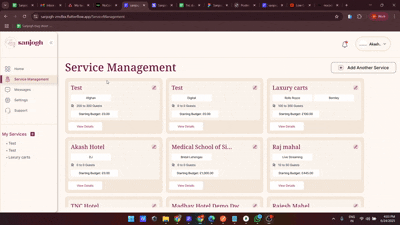In FlutterFlow, animations aren’t just about visual flair - they play a key role in enhancing user experience. While FlutterFlow offers several animation types (page load, action-triggered, and more), Implicit Animations often go unnoticed despite their simplicity and power.
Recently, while working on a project dashboard, I faced a challenge that turned into a perfect case study for using implicit animations effectively. Here’s what happened - and how FlutterFlow’s implicit animations helped me craft a smooth, professional UI.
 The Problem: Clunky Animation with Conditional Visibility
The Problem: Clunky Animation with Conditional Visibility
I wanted to create a collapsible sidebar for the dashboard - something that toggles between a compact and expanded state. My first instinct was to use Conditional Visibility based on a boolean variable.
While this worked functionally, the transition was abrupt - the sidebar snapped between states instead of sliding smoothly. Trying to apply an Action-triggered animation didn’t help much either, as it’s designed more for discrete state changes like fades, moves, or rotations tied to a button tap.
 The Solution: Implicit Animation to the Rescue
The Solution: Implicit Animation to the Rescue
To achieve a fluid and responsive animation, I switched to Implicit Animations - a powerful yet simple feature in FlutterFlow.
Here’s what I did:
- Wrapped the sidebar in a Container.
- Enabled the
Animate on State Changetoggle. - Tied the Container’s width to a state variable (say,
isExpanded). - Set different widths for collapsed (
70px) and expanded (250px) states. - FlutterFlow handled the rest - the transition was automatically animated whenever the state changed!
 The Result in Action
The Result in Action
Below is the visual proof:
![]() Expanded Sidebar with Implicit Animation:
Expanded Sidebar with Implicit Animation:

The transition is visually smooth, giving the dashboard a polished and dynamic feel - without any complex animations or custom code.
 Why This Matters
Why This Matters
- No Code Required: Implicit animations are built into the visual editor - just toggle and bind properties.
- Better UX: Smooth transitions like expanding sidebars make your app feel modern and responsive.
- Lightweight: Unlike heavy animation frameworks, implicit animations don’t impact performance.
- Scoped & Precise: You control exactly what property animates (width, padding, color, etc.).
 Final Thoughts
Final Thoughts
If you’re building with FlutterFlow and feel stuck with abrupt UI changes or clunky visual effects, Implicit Animations are your secret weapon. Whether it’s a sidebar, card expansion, or form reveal - just changing a property like width, opacity, or padding with Animate on State Change can make your app feel dramatically better.
Next time you’re debating between logic and beauty - go implicit and get both. ![]()
Share your thought’s in comment section ![]()